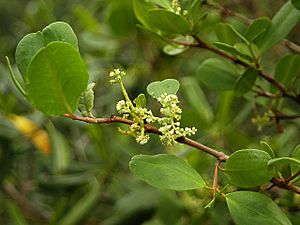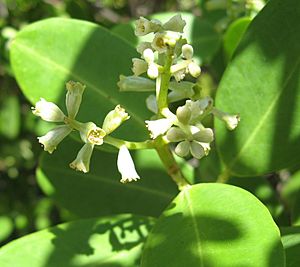Laguncularia facts for kids
Quick facts for kids Laguncularia |
|
|---|---|
 |
|
| At Caeté estuary, Bragança, Pará, Brazil | |
| Conservation status | |
| Scientific classification | |
| Genus: |
Laguncularia
|
| Species: |
racemosa
|
The white mangrove (scientific name: Laguncularia racemosa) is a special type of tree. It is the only species in its group, which scientists call a genus, named Laguncularia. White mangroves are an important part of mangrove forests. These forests grow along coastlines in tropical and subtropical areas.
Contents
Where Does the White Mangrove Grow?
This amazing tree is found in many parts of the world. On the west coast of Africa, you can find it from Senegal to Cameroon. Across the Atlantic Ocean, it grows along the coasts of the Americas. This includes places like Bermuda, Florida, the Bahamas, Mexico, and the Caribbean islands. It also grows south into Brazil.
On the Pacific side of the Americas, the white mangrove is found from Mexico down to northwestern Peru. It even grows on the famous Galápagos Islands.
What Does the White Mangrove Look Like?
The white mangrove is a medium-sized tree. It can grow to be about 12 to 18 meters (40 to 60 feet) tall. Its bark is usually gray-brown or reddish. It feels rough and has many cracks.
Roots and Bark
Depending on where it grows, the white mangrove might have special roots. Some of these are called pneumatophores. These roots stick up out of the mud or water. They help the tree breathe in salty environments. Sometimes, it also has prop roots, which grow down from the branches to support the tree.
Leaves and Flowers
The leaves of the white mangrove grow in pairs. They are shaped like an oval, about 12 to 18 centimeters (5 to 7 inches) long. They are also about 2.5 to 5.0 centimeters (1 to 2 inches) wide. The leaves are smooth and feel a bit like leather. They are slightly thick and fleshy, with a yellow-green color.
The stem that connects the leaf to the branch is called a petiole. It is strong and reddish, about 10 to 13 millimeters (0.4 to 0.5 inches) long. Near the leaf, there are two small glands. These glands actually release sugary liquids!
The flowers are small and white, shaped like bells. They are about 5 millimeters (0.2 inches) long. Most of these flowers have both male and female parts.
Fruit and Seeds
After the flowers, the tree produces a reddish-brown fruit. This fruit is called a drupe. It is about 12 to 20 millimeters (0.5 to 0.8 inches) long and has ridges along its sides. Inside the fruit, there is usually one seed. Sometimes, this seed starts to sprout while it is still on the tree. This is a special way some plants reproduce, called vivipary.
Where Does it Live?
White mangroves prefer to grow in coastal areas. You can find them in bays, lagoons, and along tidal creeks. They usually grow a bit further inland than other types of mangroves. This means they are often found in areas that are well above the high tide line.
See also
 In Spanish: Laguncularia racemosa para niños
In Spanish: Laguncularia racemosa para niños



